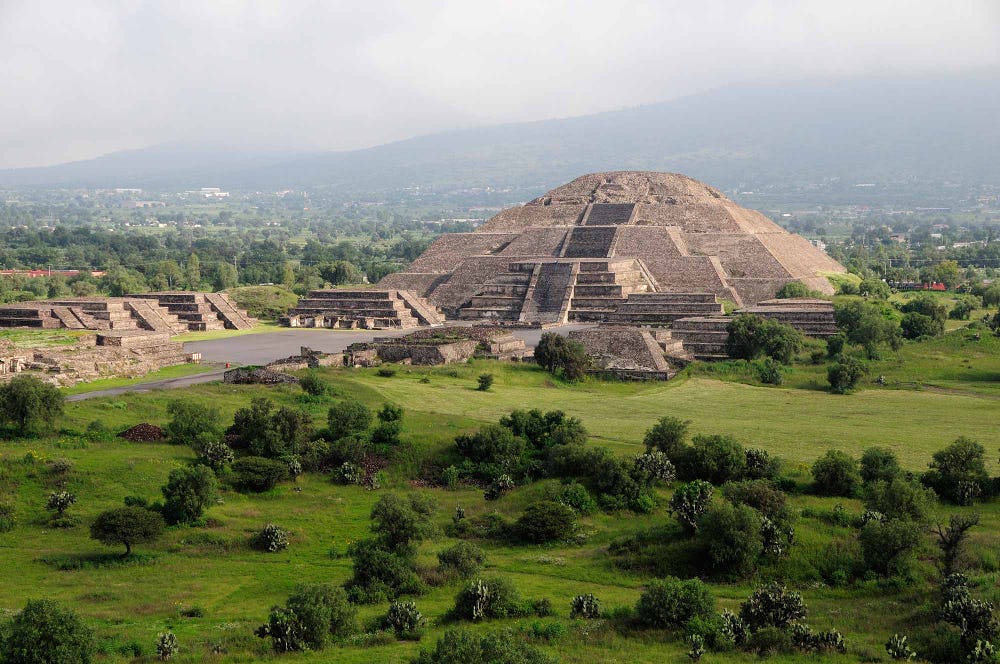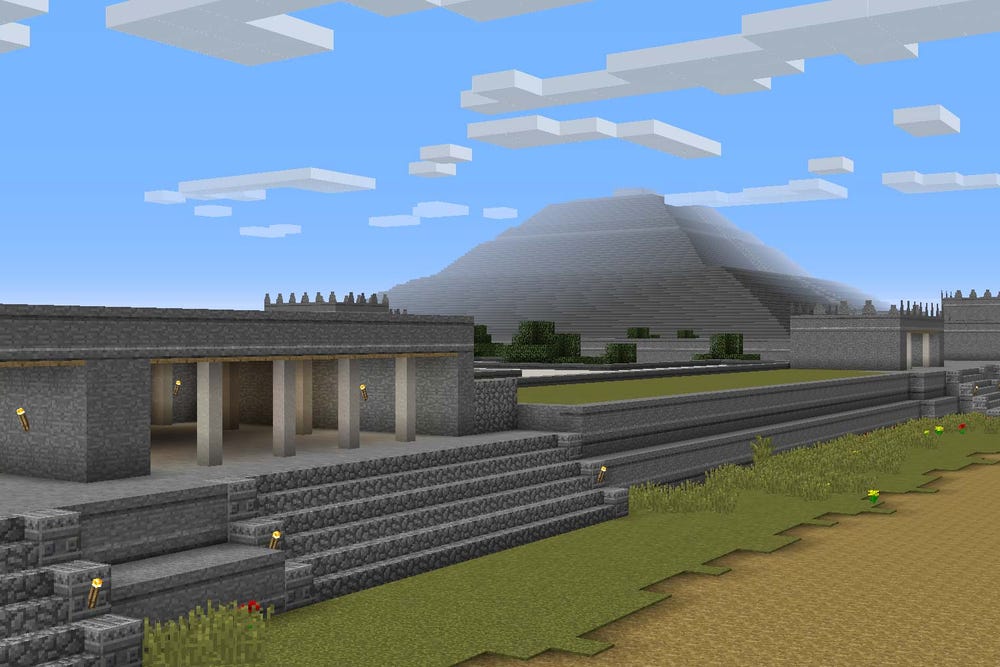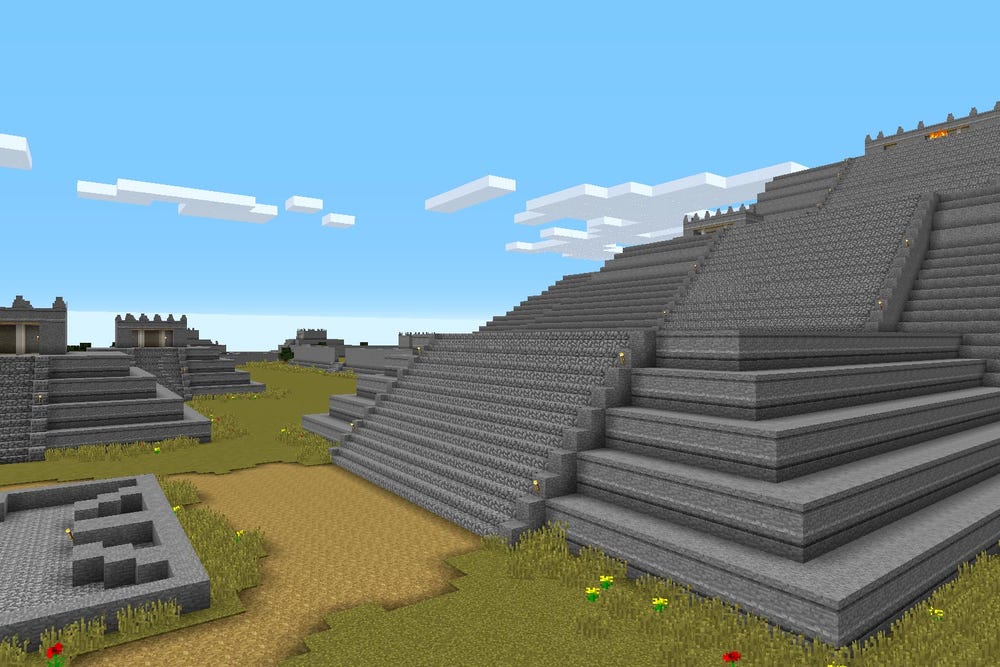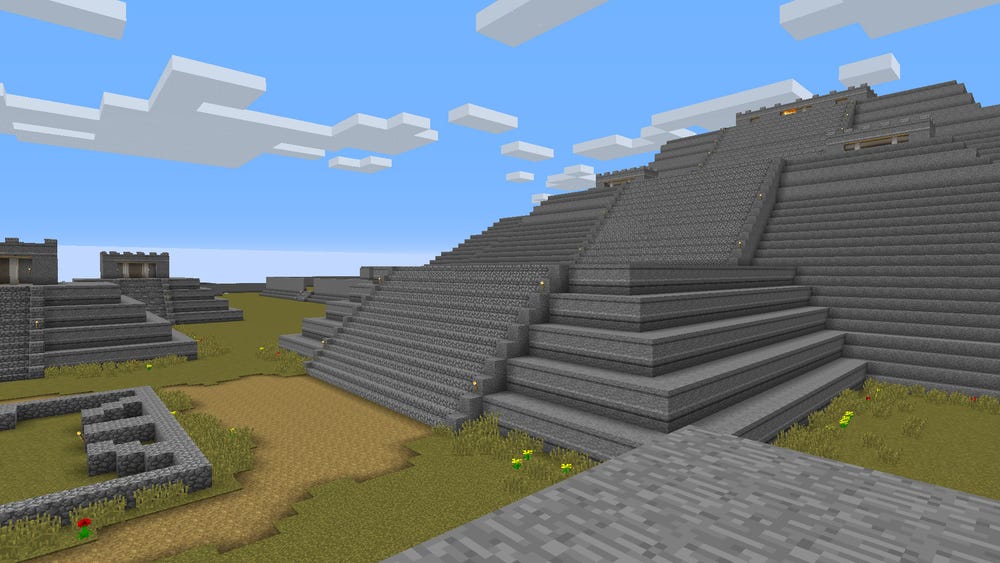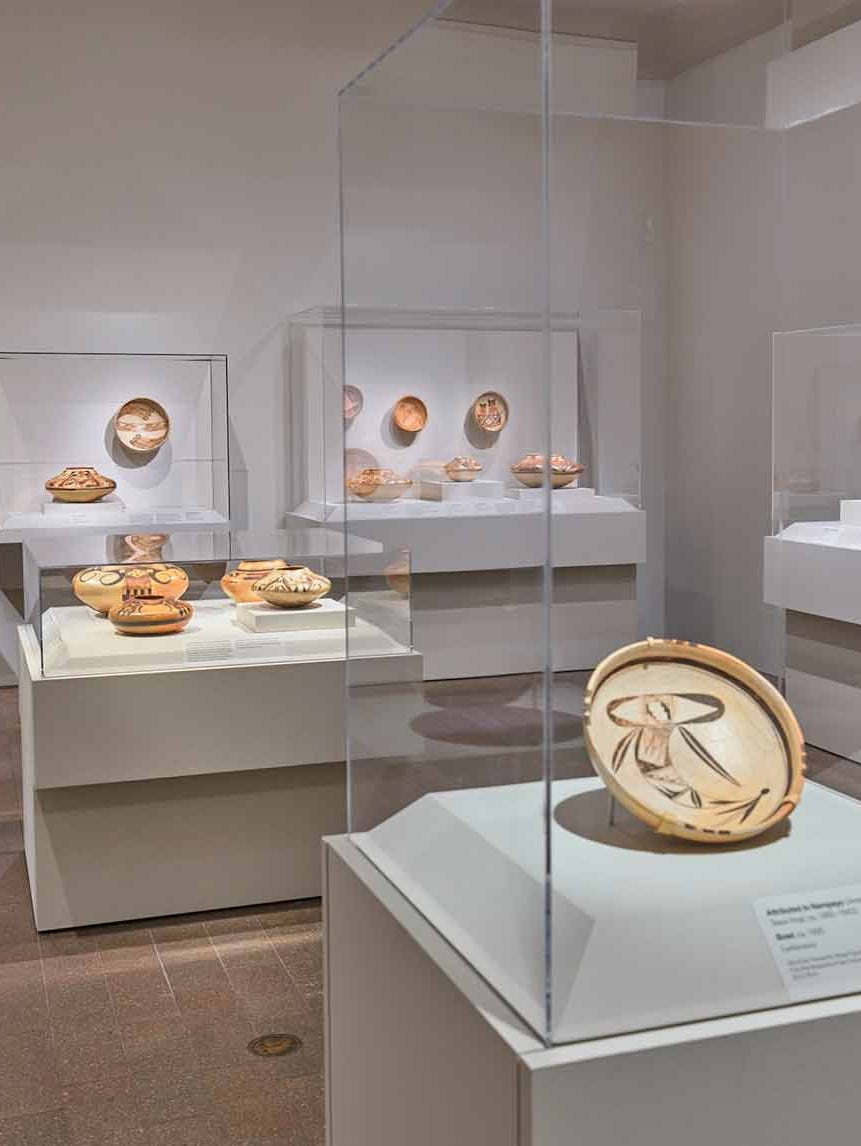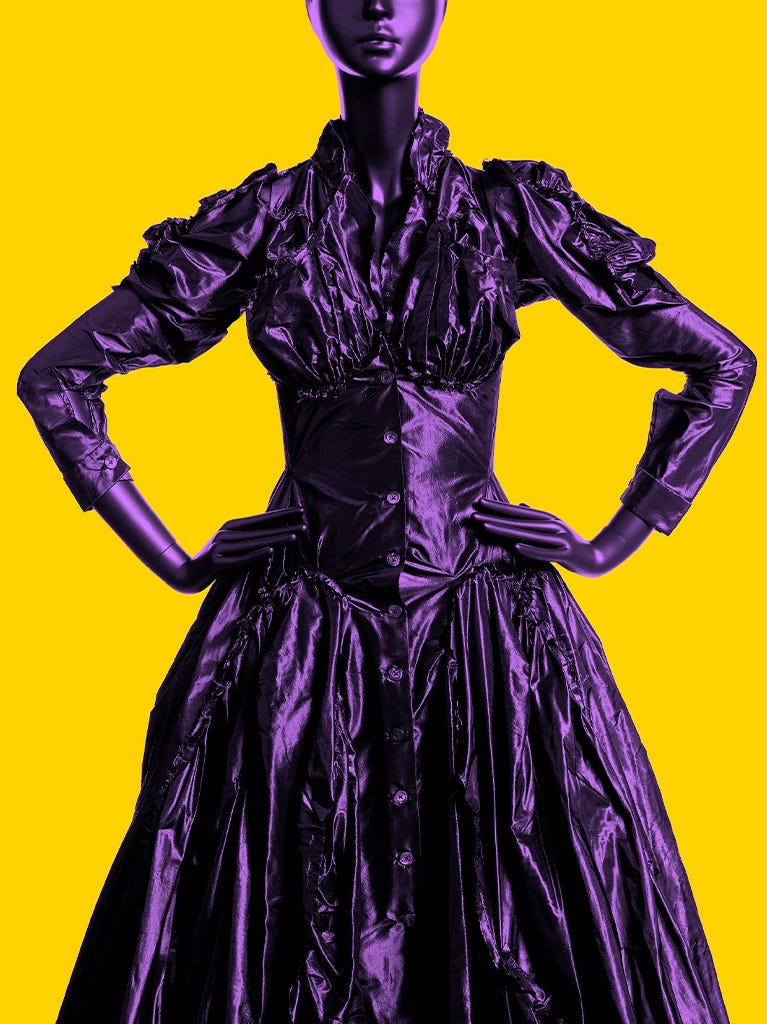Mexico, Anahuac, Teotihuacan, Smaller pyramids in the foreground of Pyramid del Sol. Photo by Eye Ubiquitous/UIG via Getty Images
Teotihuacan: City of Water, City of Fire
Teotihuacan: City of Water, City of Fire will explore how artworks from the ancient city shape our understanding of Teotihuacan as an urban environment. One of the earliest, largest, and most important cities in the ancient Americas, Teotihuacan is now a UNESCO World Heritage Site and the most visited archaeological site in Mexico. The exhibition, organized in collaboration with Mexico’s Instituto Nacional de Antropología e Historia (INAH), will feature recent, never-before-seen archaeological discoveries and other major loans from Mexican and US cultural institutions. Monumental and ritual objects from Teotihuacan’s three pyramids will be shown alongside mural paintings, ceramics, and stone sculptures from the city’s apartment compounds. By bringing these pieces together, and encouraging visitors to understand the context of specific sites within the city, the exhibition will provide a rare opportunity for Bay Area audiences to experience a significant place in Mexico's cultural landscape — the captivating and mysterious ancient city of Teotihuacan.
In depth
Teotihuacan: City of Water, City of Fire brings together art and artifacts from recent excavations with objects found as long as a century ago. These finely crafted works demonstrate how the city’s dominant ideology permeated everyday spaces, united a diverse population, and provided a guide for citizens as they navigated Teotihuacan’s streets. The Aztecs revered Teotihuacan and gave the city and its major monuments their names. This exhibition is organized geographically around these places.
The exhibition begins with recent discoveries from a tunnel found underneath the Feathered Serpent Pyramid by Mexican archaeologists in 2003. Over a decade of explorations yielded an astonishing array of objects: enigmatic sculptures that may represent Teotihuacan’s founding ancestors and large quantities of vessels depicting one of Teotihuacan’s most important deities, the Storm God. Shells likely originating from the Gulf of Mexico were also found, some incised with designs from other parts of Mesoamerica, indicating that even early in its history Teotihuacan was already a major regional hub.
Teotihuacan was a highly organized city, built in a grid like plan over roughly eight square miles, situated along the north-south axis formed by the Street of the Dead, and made up largely of architecturally similar single-story residential buildings varying in size and level of luxury. These apartment compounds housed many of Teotihuacan’s residents. The first gallery introduces the art forms for which Teotihuacan is best known and highlights important deities, including the Storm God, with his goggle eyes and distinctive nose plaque; the Old Fire God, an elderly figure who sits cross-legged and bears a brazier atop his head; the Water Goddess, known from large monuments; and the Maize God, who symbolized the life-sustaining power of this crop and may be the subject of Teotihuacan’s famous stone masks.
The next gallery showcases objects from a range of residential compounds, demonstrating aspects of daily and ceremonial life for Teotihuacan’s citizens. Immigrant groups from across Mesoamerica frequently occupied distinct neighborhoods, or barrios. Here they maintained traditions from their places of origin and simultaneously integrated themselves into the fabric of the city and its dominant ideology. In a compound on the city’s western edge, for example, people from Oaxaca carried out Zapotec lifeways, including the use of Zapotec calendrical signs. An offering on the city’s eastern edge included delicately painted ceramic figurines of women and infants. And on the city’s southern periphery, the working-class residents of Tlajinga specialized in the mass production of utilitarian obsidian blades and played a crucial role in Teotihuacan’s economy.
La Ventilla, to the southwest of Teotihuacan’s ceremonial core, is presented as an archetypal Teotihuacan residential area. Artisans from La Ventilla created spectacular artworks to satisfy local and regional markets. These included iconic ceramic tripod vessels and elaborate incense burners — or incensarios. More incensarios have been found at La Ventilla than anywhere else in the city. They were often decorated with mass-produced, mold-made clay decorations that were applied to their surfaces.
The Feathered Serpent Pyramid and the surrounding Ciudadela are next explored. Though smaller in comparison to the Sun and Moon Pyramids, the Feathered Serpent Pyramid was covered in elaborate, monumental carvings of undulating serpents. At the time of its construction, around 250 CE, a series of large-scale sacrificial offerings were made, including the burial of more than 200 individuals. Many of the victims wore necklaces of shell carved to look like human teeth — a few included actual human jawbones — and were discovered in positions that imply they were tied and bound at the time of death. These sacrifices suggest an era of significant military might at Teotihuacan.
The Sun Pyramid is Teotihuacan’s largest structure and one of the largest ever built in the ancient world. It rises about 206 feet high and was built in one single, massive construction effort around 200 CE. Recent excavations have uncovered offerings of greenstone objects and evidence for programs of exterior sculpture depicting motifs related to fire and jaguars. Large pieces have also been discovered at the pyramid’s summit, including a statue of the Old Fire God — a deity with deep roots in central Mexico; early Teotihuacan leaders sought to bind the different ethnic groups inhabiting the city together by creating a single, modified version of the Old Fire God.
After its monumental architecture, Teotihuacan is perhaps best known for its complex fresco murals, which decorated the city’s apartments and administrative centers. Stunning murals from high-status compounds in the Techinantitla section just east of the Moon Pyramid are on view in the next gallery, featuring exceptional mural fragments from FAMSF’s collection reunited with others from the same compound.
The Moon Pyramid, Teotihuacan’s second-largest structure, at a height of approximately 141 feet, is explored next. Excavations there have revealed a seven-phase construction sequence beginning sometime between 50 and 150 CE, with the monument achieving its largest size between 300 and 400 CE. During the fourth phase of construction, the pyramid was greatly enlarged, indicating a period of increasing wealth and political centralization. The completion of the construction was marked by a dedication event that involved the sacrifice of many humans and predatory animals. The sacrificial offering also included objects made of exceptionally precious materials such as greenstone, obsidian, slate, and pyrite. Many of these offerings, which were carefully arranged, seem to have connections to rituals relating to the origin of the cosmos.
The exhibition concludes at the compound of Xalla, located to the east of the Moon Pyramid plaza and just north of the Sun Pyramid. The compound was likely a site for the city’s powerful ruling elite, indicated by its architectural complexity and the large quantity of ornamental sculpture found there. Many objects from Xalla bear evidence of a violently destructive event that marked the beginning of Teotihuacan’s collapse. At around 550 CE, the ceremonial center of the city was burned; ritual objects, such as the large marble sculpture shown in the final gallery, were intentionally smashed and scattered. After the great fire, the systems of urban and religious maintenance that had been successful for more than 400 years fell apart. Much of the population left the city, and Teotihuacan’s regional dominance ended. But the site itself was never forgotten, and its legacy lives on as a powerful model of ancient Mesoamerican urbanism.
In the news
Stories
Explore with Minecraft
The free downloadable map depicts the ancient city on a 1:1 scale and allows players to experience walking along the Street of the Dead, ascending the steps to the top of the Sun Pyramid, and even exploring the recently discovered tunnel under the Feathered Serpent Pyramid.
Sponsors
This exhibition is organized by the Fine Arts Museums of San Francisco and the Los Angeles County Museum of Art, in collaboration with the Secretaría de Cultura through the Instituto Nacional de Antropología e Historia de México.
This exhibition has been made possible in part by a major grant from the National Endowment for the Humanities: Exploring the human endeavor.
Any views, findings, conclusions, or recommendations expressed in this exhibition do not necessarily represent those of the National Endowment for the Humanities.
Presenting Sponsors
Diane B. Wilsey
The Donald L. Wyler Trust
Curator’s Circle
The Charles D. and Frances K. Field Fund
Benefactor's Circle
Douglas A. Tilden
Wells Fargo
Patron’s Circle
Janet Barnes and Thomas W. Weisel Family
Walter and Elise Haas Fund
The Selz Foundation, Inc.
Additional support is provided by Carol and Lyman Casey, and Alec and Gail Merriam.
The catalogue is published with the assistance of the Andrew W. Mellon Foundation Endowment for Publications.
